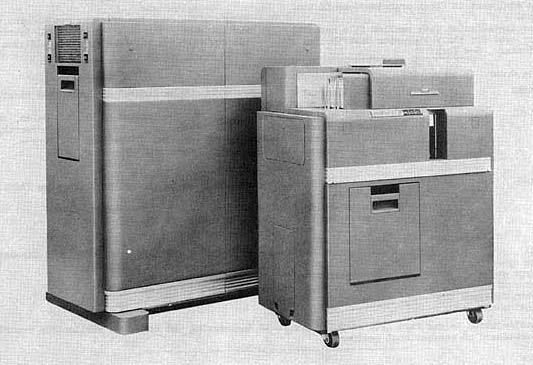The IBM 604 Electronic Calculating Punch

Watson Lab's Herb Grosch recalls [57]:
The final occupant of [the "waist" of the new IBM Watson Scientific Computing Laboratory at Columbia University, 612 West 116th Street] was the prototype, good old Serial Number Zero, of the enormously successful IBM 604 [which I installed in 1949, and it was still working away fourteen hours a day when I left in 1951]. When Mr. [Thomas J.] Watson decreed the SSEC, he also set wheels in motion "to use these electronic capabilities in the IBM." The circuits had been patented before the war, mainly by one Halsey Dickinson, whose photo showed up in the SSEC brochure.
. . .
The punch unit was much more sophisticated than the one on the 603, and the electronics box was five feet high and quite handsome, at least to someone who had had a 285, or racks of skip bars! On one end of the electronic unit was a one-panel plugboard, and it used ordinary plugwires - none of that ENIAC coax. The thing that fascinated the early users was that the machine was what we would now call microprogrammable; you could put together counters of various sizes, perform a completely flexible string of commands pipeline style, carry data over from card to card - and you could divide!In those days one of the commonest problem areas was matrix arithmetic: sets of simultaneous linear equations, and so on. I had had to do several sets of sixth order, to pretty high accuracy, in my thesis work. On the Marchant that took most of a day, and the time went up as the cube of the order - that is, a set of twelve equations would have taken eight times as long; say a full week. At the Watson Lab this was a common exercise, involving a fairly complex pattern of eight plugboards and careful sorting. On the 601 [Multiplying Punch] the time dropped by a factor of about five compared to a desk calculator, which meant that if we had been paying rent for the machines and the building, and so on, hand work would have been about as cheap...
The 602 and 602A [Calculating Punches] helped, but not by much. But the 604 ate the problem for breakfast, or so it seemed at the time; cost per hour, if the shop had been run for pay, would have been about the same, and the speed was at least six or seven times the 602A, and nearly ten times our vanishing 601s.
More images:



- IBM Calculators
- IBM 601, IBM 602, IBM 603, IBM CPC, IBM 607, IBM 608, IBM 609.
- IBM Aberdeen Relay Calculator
- Watson Lab Gallery
- W.J.E. (Wallace J. Eckert), “The IBM Pluggable Sequence Relay Calculator”, Mathematical Tables and Other Aids to Computation, Vol. 3, No. 23 (Jul., 1948), pp. 149-161.
- The Bashe [4], Pugh [40], and Grosch [57] books.
- Bell, William D., "The 'DUZ' General-Purpose Control Panel for the IBM Type 604 Electronic Calculator", IBM Technical Newsletter, No.1, IBM, New York (Jun 1950), pp.9-11 (also see Grosch, pp.107-108, about Bill Bell).
- Nims, Paul T., "The IBM Type 604 Electronic Calculating Punch as a Miniature Card Programmed Electronic Calculator", Proceedings, Computation Seminar, IBM, New York (Aug 1951), pp.37-47.
- IBM Scientific Computing Forum Proceedings and Technical Newsletters from the 1950s are full of articles describing 604 applications and techniques, of which the two just above are samples.
- IBM 604 Calculating Punch Manual of Operation (IBM)
- IBM 604 (Ballistic Research Laboratories, Aberdeen Proving Ground: A Third Survey of Domestic Electronic Digital Computing Systems, Report No. 1115, March 1961, Martin Weik.)
- IBM-604 (Ed Thelen).
- The IBM 604 Electronic Calculating Punch (University of Amsterdam Computer Museum)
- IBM 604 Principles of Operation (IBM, Ed Thelen)
- IBM 604 Manual of Operation (IBM, Ed Thelen)
- IBM through the years: 1948 (IBM)
- The POET Effect - The Persistence of Established Technology (Bob Bemer Computer History Vignettes)
- IBM 604 Ad plugging pluggable units
- La "Comptometrista" (Italian Ad)
- More Photos (Dan McCracken)